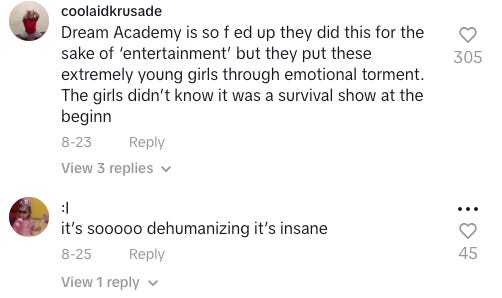The good and the ugly behind "Pop Star Academy"
Why the K-pop methodology doesn't neatly map onto the global show behind Katseye, a new girl group.
I finished watching all eight episodes of Pop Star Academy: KATSEYE this past weekend while traveling to Atlanta for a wedding — this says a lot, since I’m usually physically incapable of bingeing TV. The Netflix docuseries follows 20 aspiring pop stars as they undergo a rigorous two-year K-pop training program, culminating in the selection of six trainees for the new girl group Katseye.
I’ve always been fascinated by the notion of who can be a K-pop star, particularly as K-pop has become increasingly globalized (I also wrote this Daily Beast story about a K-pop training center in NYC). There’s also the related question of what it takes to make a star, or, in K-pop parlance, an idol. What’s enthralling about Pop Star Academy is that it pulls back the curtains on both these questions, offering a glimpse into the elusive, backbreaking process of creating K-pop idols.
Throughout the training and development stage of the program (referred to as T&D), the girls are judged across four categories: singing, dancing, visual performance, and the ineffable “star quality.” What the girls don’t know is that after T&D, they’ll be thrust into a survival show, where trainees are eliminated in successive rounds based on both fan voting and performance evaluations by coaches and execs from HYBE (the South Korean entertainment giant behind the likes of BTS and NewJeans) and Geffen (which backs big artists like Olivia Rodrigo, Kali Uchis, and Camila Cabello).
And that’s where things get a little ugly, exposing some not-so-glamorous realities about how K-pop stars are made. I’ll briefly discuss three things that stood out to me below (note: some general spoilers from here on out):
The K-Pop training system doesn’t 100% neatly map onto a global landscape
I think all the trainees in the show are incredibly talented and I’d say I’m a real fan of Katseye. I’ve been constantly dazzled by their effortlessly in-sync dance moves and enviable vocal skills — which we see are the result of countless hours of practice. What made Pop Star Academy so enthralling — and discomfiting — is the inside look it offers into the infamously strict K-pop trainee system, which consists of grueling 12-hour days, physical injuries, and cutting feedback, all of which is geared toward creating idols, the ultimate final product.
All that said, the show also reveals moments when the Korean entertainment principles that make K-pop so successful don’t always seamlessly map onto a more Americanized/global landscape. It’s most clearly shown in the varying approaches the Korean vs. American executives and coaches take toward the girls. In one episode, Sun, a HYBE exec behind BTS, gets upset at the trainees for failing to properly respect the meaning behind the song and, by extension, the legacy of K-pop. On the other hand, an American exec on the show says they want to “take the ‘K’ out of K-pop and make it global.” There’s some clunkiness here, a mismatch that comes to a head once the show transitions into its survival show phase.
Surprise, management is evil and drama sells
There’s been a lot of backlash against HYBExGeffen for how they seemed to prioritize competition in the name of entertainment over the wellbeing of these young women, the youngest of whom was 14 (!). During T&D, the trainees weren’t told they would be put into a survival show, which thrust them into the public eye and put them at the mercy of “fan’s” voting.
Things came to a head when, during one of the elimination rounds, the girls and the public are shown clips of themselves sharing who they’d want (and not want) to debut with. They were told these interviews would not be shown to others, according to one of the trainees. An exec says point blank on screen: “It’s a survival show. You have to create that drama. You have to create that competition. It’s entertainment. That’s what the fans want.”
But is it? Not from the backlash I’ve seen. At this point, the whole program has become a big popularity contest, and it’s heartbreaking to watch the girls, who’ve really bonded and built up real, beautiful friendships that are often only so easily formed among young women, be ranked in such a viciously public way. This quickly comes to bite management’s butts when one of the leading trainees — a darling among the execs — announces she’s leaving the show soon after, refusing to subscribe to this model of competition.

That elusive star quality is inextricably tied with pretty privilege
This is far from a novel take, but the sad reality of being a star, and especially a K-pop star, is that looks do matter. The Pop Star Academy execs basically say as much: In one episode after the survival show phase begins, a super-talented trainee doesn’t get many fan votes. An exec describes how fans have an expectation of what a K-pop star looks like (i.e., thin, of a certain height, pretty) and that trainee just doesn’t fit that look. The show also displays screenshots of social media comments about how one girl’s eyes are too far apart, or how another girl’s lips are too big.
It’s no surprise that the final six who end up forming Katseye are all slender and beautiful. It is nice to see racial and ethnic diversity in what’s billed as a global girl group, but thinking about the trainees who were presumably dropped because they didn’t fit the image fans have of a pop star is a little sad. Pop Star Academy had the opportunity to really create something novel, to break industry norms, but it only ended up reaffirming standards that have been upheld for centuries, across cultures and geographies.
Have you watched Pop Star Academy? I’d love to hear your thoughts in the comments.





